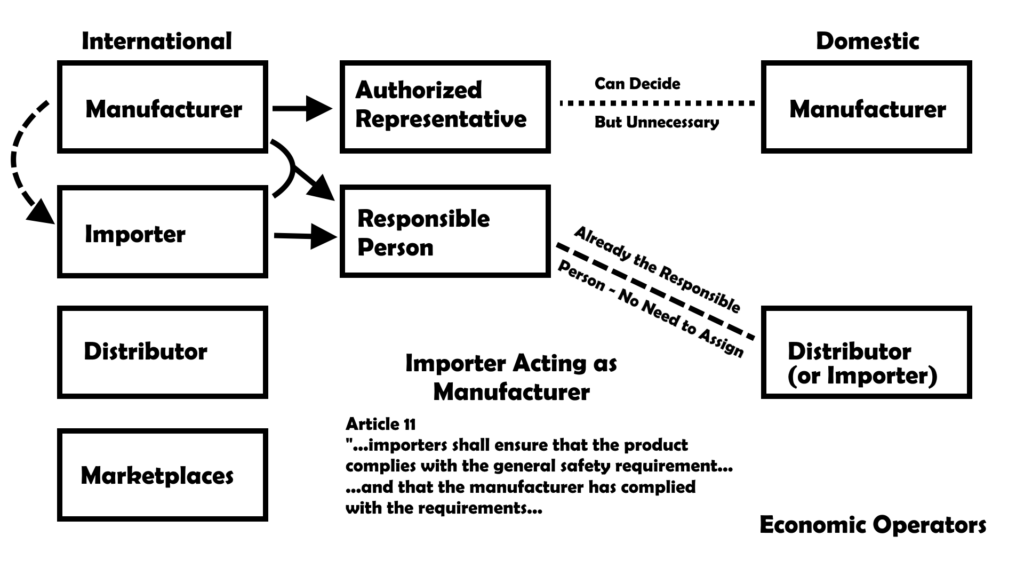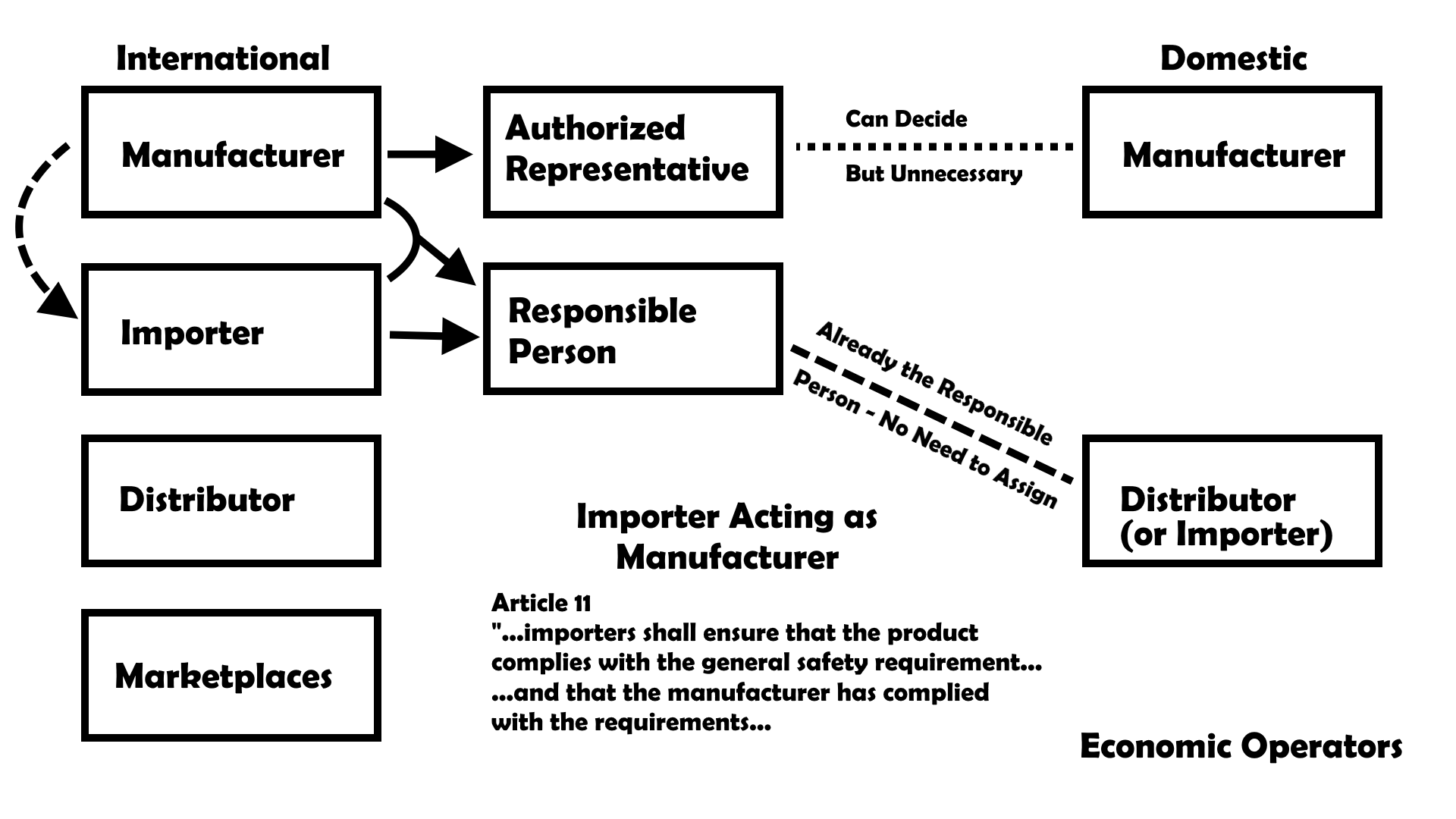I’m going to try to keep this nice and simple for you, so little legalese and short descriptions. In this video, I will be covering the different types of entities along the sales chain and others connected.
~~A quick note is this text includes extra information not included in the video, as I purposefully left out some information to keep the video tighter.~~
There are three main types of market entities, or “economic operators,” that engage in the production, distribution, and sale of products. The lines of each and definitions may differ from your understanding, but these were set up to at least have decent definitions for this regulation.
To start out, a “natural person” is a living, breathing human being. A “legal person” is an entity that doesn’t exist in nature but has been given legal rights or privileges – such as an established business or non-profit. This is to further instill the point that it doesn’t matter if you don’t have a company – if you target the EU market, your products are regulated by the GPSR.
The first is “manufacturer,” which means any natural or legal person who manufactures a product or has a product designed or manufactured, and markets that product under that person’s name or trademark.
“Under that person’s name or trademark” is for anyone who buys and sells products someone else manufactured, but sells them under their own brand – also known as white labeling.
The second is “importer,” which means any natural or legal person established within the Union who places a product from a third country on the Union market.
This is perhaps the easiest form to understand, as it’s limited to being the entity that moved the foreign object onto the EU market. The importer can also be the operator who sold the product to an end consumer.
The third is “distributor,” which means any natural or legal person in the supply chain, other than the manufacturer or the importer, who makes a product available on the market.
This is every step from manufacturer (or importer) to customer, including all B2B sales.
Each economic operator is supposed to keep track of who they bought from and sold to. This way, a product can be tracked all the way from the manufacturer to the customer simply by following this chain.
~~I am of the personal opinion that the exact lines for these will be partially ignored by the regulators as long as the intent is followed. Why is this? Because the text states that the importer has to be physically established in the EU and the distributor is neither the manufacturer nor the importer. It is a bit contradictory, as this appears that a foreign manufacturer cannot place a product on the market (via direct sales), so I think one of these options will take place:
- One foreign economic operator can be the manufacturer, importer, and distributor all at once.
- The foreign manufacturer can also be the distributor (no establishment in the EU, so no importer).
- One foreign economic operator can be the manufacturer and importer, with there being no distributor.
I would rather play it safe, so I would list myself as all three on documentation, products, and websites.~~
This brings me to this chart, which I’ve made as simple as possible.

As you can see, there are three extra economic operators.
Authorized representative, responsible person, and marketplaces.
An “authorized representative” means any natural or legal person established within the Union who has received a written mandate from a manufacturer to act on that manufacturer’s behalf in relation to specified tasks with regard to the manufacturer’s obligations under this Regulation.
To put it simply, this is just a person who is physically in the EU and will collect data, transmit any necessary data to the European Commission, communicate with the Commission and customers, and operate any required product recalls or maintenance.
A “responsible person” is simply the person who is taking over the responsibilities of each role.
And a “marketplace” is any online marketplace, like eBay, Etsy, or Mercari, that enables sales to the EU.
The chart has two main columns. International and domestic.
An international manufacturer who doesn’t engage with the EU market and doesn’t intend to sell their products to the EU doesn’t need to abide by any EU regulations. It is in no way under the scope of the GPSR. If, though, the manufacturer sells something to another business while knowing that business will sell to the EU, they do have to ensure their products abide by the GPSR. This is a lot of fun.
The regulation allows manufacturers to have an authorized representative in the EU to perform all its GPSR obligations. This can be just any person who can do the task, or they can have another company down the line – which would quite likely be the importer – operate as the authorized representative. This decision is left up to the manufacturer.
If you are selling your items to businesses in the EU, I’d suggest that you pick one to act as the authorized representative. You can have one representative per product, but that gets messy. If you manufacture more than a couple types of products, it is probably best just to hire someone outside the chain of sales to be your authorized representative.
Next up is the importer. As previously stated, the importer simply is the operator who moved the product from outside the EU to within the EU.
If the importer is outside of the European Union, they need to have a responsible person within the EU to be held liable for following the GPSR.
If you make something and then sell it directly to a customer in the EU, then you are both the importer and the manufacturer. Because you’re selling to a customer in the EU, you need to have a responsible person. The responsible person is basically the authorized representative with more duties, so you then don’t need an authorized representative anymore.
This next piece isn’t explicitly stated in the EU, but it’s implied.
If an importer imports a product that wasn’t intended to be sold into the EU, they are assuming the role of the manufacturer.
The GPSR says that importers are obligated to ensure that the product complies with the general safety requirements and that the manufacturer has complied with the requirements.
To describe this with a few more details, if a product was made to be exclusive to one market, such as a CD or video game made for sale only in Japan, the manufacturer made no attempts to verify that it is in compliance with EU regulations. Because of this, the importer becomes the responsible person for all of the manufacturer’s obligations.
Details on how to abide by the GPSR in this instance will be covered in another video.
If the manufacturer and importer didn’t sell to an end consumer, then the distributor steps in.
Because the product isn’t being sold by the manufacturer or importer, the manufacturer needs an authorized representative and the importer needs a responsible person.
The EU is pushing marketplaces to voluntarily conform to its regulations. By volunteering, they then are required to ensure sellers are at least appearing to abide by the EU’s regulations. This will be covered in another video/post.
Now for those within the EU.
If you make something in the EU, you are responsible for reporting everything yourself. You can hire someone else to be your authorized representative, but it’s unnecessary. This decision is left up to you, though.
The distributor of a domestically-made item is already the responsible person and doesn’t need to assign this role. The same goes for importers physically in the EU.
Each person’s situation is different, interpretation of these regulations are left up to the courts, and regulations change all the time. So, if you are unable to determine where you fit along this chain, I suggest reaching out to a knowledgeable lawyer.

Leave a Comment